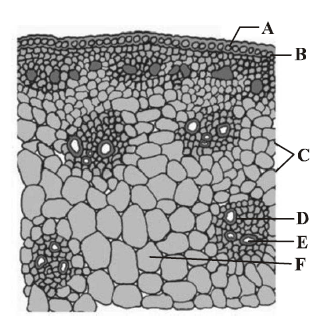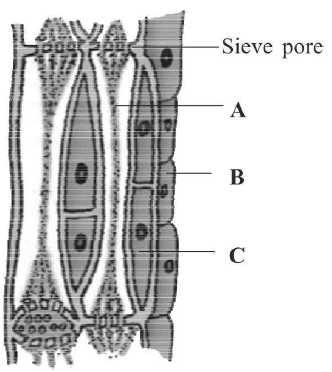A tissue is a group of cells which are
similar in origin, but dissimilar in form and function.
dissimilar in origin, form and function.
dissimilar in origin, but similar in form and function.
similar in origin, form and function.
Correct Answer :
D. similar in origin, form and function.
A group of structurally similar or dissimilar cells that perform a common function and have a common origin is called a tissue. A plant is made up of different kinds of tissues. The complex tissues are, however, composed of different kinds of cells and they perform different types of functions.
Related Questions
In the given columns, column I contain structures of female reproductive system and column II contain its feature. Select the correct match.
| Column-I | Column-II |
|---|---|
| A. Lateral meristem | (i) Fascicular vascular cambium, interfascicular cambium and cork cambium. |
| B. Apical meristem | (ii) Produces dermal tissue, ground tissues and vascular tissue. |
| C. Bast fibres | (iii) Generally absent in primary phloem but found in secondary phloem. |
| D. Sap wood | (iv) Involved in the conduction of water and minerals from the root to leaf. |
A - (i), B - (ii), C - (iii), D - (iv)
A - (iii), B - (i), C - (ii), D - (iv)
A - (i), B - (iv), C - (iii), D - (ii)
A - (ii), B - (iv), C - (iii), D - (i)
Cork is formed from
phellogen
vascular cambium
phloem
xylem
Which one of the following have vessels as their characteristic feature?
Angiosperms
Gymnosperms
Pteridophytes
Bryophytes
An organised and differentiated cellular structure having cytoplasm but no nucleus is called _________.
vessels
xylem parenchyma
sieve tubes
tracheids
Which of following helps bamboo and grasses to elongate ?
Apical meristems
Lateral meristems
Secondary meristems
Intercalary meristems
Match the elements of xylem given in column I with their character given in the column II and choose the correct option.
| Column-I | Column-II |
|---|---|
| A. Xylem vessels | I. Store food materials |
| B. Xylem tracheids | II. Obliterated lumen |
| C. Xylem fibres | III. Perforated plates |
| D. Xylem parenchyma | IV. Chisel-like ends |
A IV; B III; C II; D I
A III; B II; C I; D IV
A II; B I; C IV; D III
A III; B IV; C II; D I
Apical, intercalary and lateral meristems are differentiated on the basis of
origin
function
position
development
Which meristem helps in increasing girth?
Lateral meristem
Intercalary meristem
Primary meristem
Apical meristem
The given figure shows T.S. of monocot stem. Identify the correct labelling of A to F marked in the given figure.

A Epidermis, B Hypodermis, C Vascular bundles, D Phloem, E Xylem, F Ground tissue
A Cuticle, B Epidermis, C Sclerenchymatous sheath, D Sclerenchymatous hypodermis, E Parenchymatous sheath, F Phloem
A Cuticle, B Epidermis, C Sclerenchymatous hypodermis, D Sclerenchymatous sheath, E Parenchymatous sheath, F Phloem
A Cuticle, B Epidermis, C Sclerenchymatous hypodermis, D Sclerenchymatous sheath, E Parenchymatous sheath, F Protoxylem
Which of the following statement(s) is/are correct ?
- Uneven thickening of cell wall is characteristic of sclerenchyma.
- Periblem forms cortex of the stem and the root.
- Tracheids are the chief water transporting elements in gymnosperms.
- Companion cell is devoid of nucleus at maturity.
- The commercial cork is obtained from Quercus suber.
(i) and (iv) only
(ii) and (v) only
(iii) and (iv) only
(ii), (iii) and (v) only
Match the followings and choose the correct option
| Column-I | Column-II |
|---|---|
| A. Cuticle | I. Guard cells |
| B. Bulliform cells | II. Outer layer |
| C. Stomata | III. Waxy layer |
| D. Epidermis | IV. Empty colourless cell |
A III, B IV, C I, D II
A I, B II, C III, D IV
A III, B II, C IV, D I
A III, B II, C I, D IV
The apical meristem of the root is present
in all the roots.
only in radicals.
only in tap roots.
only in adventitious roots.
A tissue is a group of cells which are
similar in origin, but dissimilar in form and function.
dissimilar in origin, form and function.
dissimilar in origin, but similar in form and function.
similar in origin, form and function.
A student was given a tissue to observe under the microscope. He observes the tissue and concludes that the tissue is a type of simple plant tissue and provides mechanical support to young stem and petiole of leaf.
Identify the tissue.
Parenchyma
Collenchyma
Sclerenchyma
Xylem parenchyma
Match the terms given in column I with their funciton given in column II and choose the correct option.
| Column-I | Column-II |
|---|---|
| (Term) | (Functions) |
| A. Meristem | I. Photosynthesis, storage |
| B. Parenchyma | II. Mechanical support |
| C. Collenchyma | III. Actively dividing cells |
| D. Sclerenchyma | IV. Stomata |
| E. Epidermal tissue | V. Sclereids |
A I, B III, C V, D II, E IV
A III, B I, C II, D V, E IV
A II, B IV, C V, D I, E III
A V, B IV, C III, D II, E I
T.S. of dicot leaf passing through the midrib is given below. Certain parts have been marked by alphabets (A to H). Choose the option showing their correct labelling.

A Epidermis, B Spongy mesophyll, C Palisade mesophyll, D Stomata, E Guard cells, F Phloem, G Metaxylem, H Protoxylem
A Epidermis, B Palisade mesophyll, C Spongy mesophyll, D Sub-stomatal cavity, E Stoma, F Phloem, G Xylem, H Bundle sheath
A Epidermis, B Palisade mesophyll, C Spongy mesophyll, D Stomata, E Guard cells, F Epidermis, G Xylem, H Phloem
A Epidermis, C Palisade mesophyll, C Spongy mesophyll, D Stomata, E Guard cells, F Phloem, G Metaxylem, H Protoxylem
In the given figure of phloem tissue, identify the marked part (A, B and C) which help in maintaining the pressure gradient
in the sieve tubes.

A
B
C
None of the above
Match the terms given in column I with their features given in column II and choose the correct option.
| Column-I | Column-II |
|---|---|
| (Terms) | (Features) |
| A. Fibres | (i) Cells are living and thin walled with cellulosic cell wall, store food materials in the form of starch or fat |
| B. Sclereids | (ii) Main water conductive cells of the pteridophytes and the gymnosperms |
| C. Tracheids | (iii) Thick walled, elongated and pointed cells, generally occurring in groups |
| D. Vessels | (iv) Long cylindrical tube like structure and cells are devoid of protoplasm. Characteristic feature of angiosperms |
| E. Xylem parenchyma | (v) Reduced form of sclerenchyma cells with highly thickened lignified cellular walls that form small bundles of durable layers of tissue in most plants. |
A - (i), B - (ii), C - (iii), D - (iv), E - (v)
A - (iii), B - (v), C - (ii), D - (iv), E - (i)
A - (iii), B - (i), C - (v), D - (ii), E - (iv)
A - (v), B - (iv), C - (iii), D - (i), E - (ii)
In land plants, the guard cells differ from other epidermal cells in having
cytoskeleton.
mitochondria.
endoplasmic reticulum.
chloroplasts.
Cork cambium and vascular cambium are
the parts of secondary xylem and phloem.
the parts of pericycle.
lateral meristems.
apical meristems.
The length of different internodes in a culm of sugarcane is variable because of
size of leaf lamina at the node below each internode
intercalary meristem
shoot apical meristem
position of axillary buds
Various functions like photosynthesis, storage, excretion performed by _____________.
sclerenchyma
parenchyma
collenchyma
aerenchyma
When we peel the skin of a potato tuber, we remove
periderm
epidermis
cuticle
leaves
Cambium is considered as a lateral meristem because
it gives rise to lateral branches.
it causes increase in girth.
it increases height and diameter of a plant.
it adds bulk to a plant.
Match the names of the structures given in column-I with the functions given in column-II, choose the answer which gives the correct combination of the two columns :
| Column-I | Column-II |
|---|---|
| (Structure) | (Function) |
| A. Stomata | I. Protection of stem |
| B. Bark | II. Plant movement |
| C. Cambium | III. Secondary growth |
| D. Cuticle | IV. Transpiration |
| V. Prevent the loss of water | ... |
A V, B III, C I, D IV
A I, B IV, C V, D III
A II, B IV, C I, D III
A IV, B I, C III, D V
Which type of plant tissue is being described by the given statements?
- It consists of long, narrow cells with thick and lignified cell walls having a few or numerous pits.
- They are dead and without protoplasts.
- On the basis of variation in form, structure, origin and development, it may be either fibres or sclereids.
- It provides mechanical support to organs.
Parenchyma
Sclerenchyma
Collenchyma
Chlorenchyma
A piece of wood having no vessels (trachea) must be belonged to
teak
mango
pine
palm
Cells of permanent tissues are specialized
functionally.
only structurally.
both structurally and functionally.
for mitosis.
Xylem functions as a conducting tissue for water and minerals from _________to the ______and__________.
roots, stems, leaves
stems, roots, leaves
leaves, stems, roots
leaves, stems, leaves
The __________ occurs in layers below the epidermis in dicotyledonous plants.
parenchyma
sclerenchyma
collenchyma
aerenchyma
